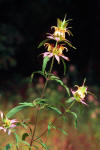WILD
FOODIES' HOME PAGE
PLANT PROFILE LIST
NAME: Horsemint
SPECIES / FAMILY: Monarda Punctata / Lamiaceae
OTHER COMMON NAME(S): Spotted beebalm
CONDITIONS:
sun/partial shade
|
PARTS: |
EDIBLE |
TASTE |
RAW/COOK |
SEASON |
|
All |
|
|
|
|
|
Shoots |
|
|
|
|
|
Leaves |
|
mint |
RAW/COOK |
Summer |
|
Stalk/Stem |
|
|
|
|
|
Buds |
||||
|
Flowers |
|
mint |
RAW |
Summer |
|
Fruits |
|
|
|
|
|
Pods |
|
|||
|
Seeds |
|
|
|
|
|
Nuts |
|
|
|
|
|
Roots |
|
|
|
|
|
Bark |
|
|
|
|
PORTION: small
COMMENT: Leaves - raw or cooked. A strong aromatic taste, they are used as a flavouring in salads and cooked foods, and also as an aromatic tea.(1)
CAUTION: Excessive mint exposure may cause an arthritic condition.
NUTRITION/MEDICINAL: Antiseptic; Carminative; Diaphoretic; Diuretic; Emmenagogue; Rubefacient; Stimulant; Stomachic; Vesicant. Horse mint was traditionally taken by several native North American Indian tribes to treat nausea and vomiting, and to encourage perspiration during colds. It was also applied externally as a poultice to treat swellings and rheumatic pains. Nowadays it is used primarily to treat digestive and upper respiratory tract problems.(1)
LOOK-A-LIKES:
POISONOUS LOOK-A-LIKES:
OTHER USES: Essential oil; Incense.The plant has a pleasing aroma and has been hung in the house as an incense.(1) Any mint is an insect and rodent repellent, just put some in a blender with water, sieve out fiber, use mint water to damp mop and dust. Also use to rinse woolen clothes to keep moths away.
SOURCE LINKS (may include nutritional and medicinal info, plus other uses):

_small.jpg)
_small.jpg)
